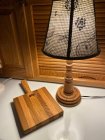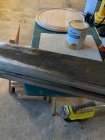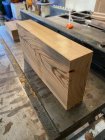-
July 2025 Turning Challenge: Turn a Multi-axis Weed Pot! (click here for details) -
Congratulations to Kent Reisdorph for "Sugarberry Bowl" being selected as Turning of the Week for July 14, 2025 (click here for details) -
Welcome new registering member. Your username must be your real First and Last name (for example: John Doe). "Screen names" and "handles" are not allowed and your registration will be deleted if you don't use your real name. Also, do not use all caps nor all lower case.
You are using an out of date browser. It may not display this or other websites correctly.
You should upgrade or use an alternative browser.
You should upgrade or use an alternative browser.
another "what wood is this"
- Thread starter Henry Novak
- Start date
Many old tanks were made of Port Orford Cedar.
- Joined
- Apr 27, 2004
- Messages
- 9,236
- Likes
- 5,896
- Location
- Lakeland, Florida
- Website
- www.hockenberywoodturning.com
Looks like cypress and cypress is light weight.
Could be some other conifer too.
Could be some other conifer too.
Not sure, but long leaf southern yellow pine could be another possibility. My dad's business took down an old ware house, 100+ years, and all the beams and joists were the yellow pine. We thought it was Doug Fir at first, but the pine would have been much easier to ship up the Missouri River. Not sure how it would do for a water tank compared to the cypress.
robo hippy
robo hippy
- Joined
- Jul 18, 2018
- Messages
- 1,272
- Likes
- 2,667
- Location
- Baltimore, MD
- Website
- loujacobswoodturning.com
I thought of southern yellow pine also. Usually you’d be able to cut it and smell a turpentine odor. I’m not sure how this one, having been used for years for oil storage might have affected that, but it’s worth shaving a piece toward the outside (away from the oil surface) of the tank and giving a sniff. I repurposed an old kitchen table I made with SYP construction lumber 40 years ago. When I turned a piece on the lathe, it still had that distinctive smell.
Yellow pine has some heft to it (dense) and a very distinct pine pitch smell regardless of the age of the timber. The grain pattern, softness, and light weight lead me to think that we are talking about cypress here.From a 100+ year old outdoor round oil tank in the Pennsylvania woods. Would have thought it would be white oak but after cleaning and planing, think its cypress. Its not very hard and is lightweight.
View attachment 35847 View attachment 35848
I would place my bets on cypress too because of its extreme weather and rot resistance making it an ideal choice.
That looks the same as some very old (100+) pieces of a beam from an old warehouse I got from a friend. He said it was called heart pine. It also had the dark areas in it from where it was in contact with metal over the years. You could smell the distinct pine once you cut into it. I turned some thin wall bowls out of it and in the right light the pitch areas would glow through like a candle Very neat. I still have a small blank on my shelf. Went and grabbed it and it looks like you had cut it off from the end of what you have.
If it's old growth long leaf yellow pine (also called heart or pitch pine) it will weigh about the same as white oak. It was not commonly used for water tank staves but I've never run across a wooden oil tank so wouldn't know it that was a common use for it. Cypress would be about the weight of the current doug fir framing lumber but gets quite heavy when swelled up. Port orford cedar is quite light and was often used for water tanks. Western red and northern white cedar where also used for water tanks and would also be fairly light in weight. If it's heart pine you should notice the scent of turpentine when you cut it.
It smells strongly of oil from the decades holding crude. The smell is so powerful that i can smell it 10 ft away. I'm also sure it hasn't seen oil in 50 years. Here's 2 items I made from the pieces I cut off - the cutting board has alternating cherry wood for some contrast. for the lamp, even after three coats of Varathane poly, the smell still comes through.If it's old growth long leaf yellow pine (also called heart or pitch pine) it will weigh about the same as white oak. It was not commonly used for water tank staves but I've never run across a wooden oil tank so wouldn't know it that was a common use for it. Cypress would be about the weight of the current doug fir framing lumber but gets quite heavy when swelled up. Port orford cedar is quite light and was often used for water tanks. Western red and northern white cedar where also used for water tanks and would also be fairly light in weight. If it's heart pine you should notice the scent of turpentine when you cut it.

- Joined
- Jul 18, 2018
- Messages
- 1,272
- Likes
- 2,667
- Location
- Baltimore, MD
- Website
- loujacobswoodturning.com
Beautiful, but I’m not sure I’d want to use a cutting board smelling so strongly of crude oil. Then again, maybe an oil baron would love it. Smells like money!
Beautiful, but I’m not sure I’d want to use a cutting board smelling so strongly of crude oil. Then again, maybe an oil baron would love it. Smells like money!
yes - I'll only use it as a display board or a hot pad - the smell is still too strong
I was given a 60-80 year old picnic table to cut up for stock. the lady told me another neighbor had made it for her and she said she remembered he said it was cypress. its color/ grain apperance looked just like this piece. I for one did not like the stuff. had nasty smell and felt almost greasy. but had been outdoors for all that timeI made a few things from it, not sure I have any around any more. every part of it was an inch thick except the legs which I burnt rather than keep.


